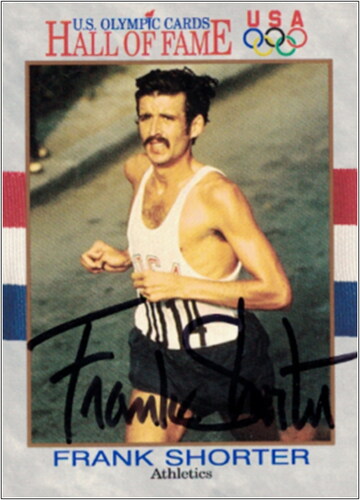I started jogging at age 32 in 1970 but jogged only about a mile a day in the morning. One of our neighbors then said he was going to run the 6.2-mile Peachtree Road Race on July 4 in Atlanta. A race that long seemed impossible to me, but I had to see it. After watching it a few years, I completed the race in 1975. Once before the race, I was at the Piedmont Hospital Conference and some of the older doctors asked, “Are any of you running that race in front of our hospital on top of that long hill? Some of the runners may have to be treated in the emergency room.” They viewed running as dangerous. But with my experience, I began inviting many patients to start running 10k races and also suggested that patients quit smoking and instead take up running. I began the ACT—Atlanta Coalition Against Tobacco. As I got more into running, Jeff Galloway became my mentor, and I was able to finish the Boston Marathon in April 1978, at the age of 40, with a time of 3 hours and 47 minutes.
My experience with running in the 1970s made me want to investigate its recent history. Coach Arthur Lydiard in New Zealand began the world’s first jogging club in Auckland in 1961 (). He is credited with popularizing the sport of running and making it commonplace across the world.Citation1 Lydiard was a great runner and teacher and competed in marathons. Runner’s World has hailed him the “all-time best running coach.” He was also a strong promoter of running for health, encouraging easy distance running for its cardiovascular health benefits.
Figure 1. Arthur Lydiard in the New Zealand Marathon Championships, March 1949. Photo in the public domain.
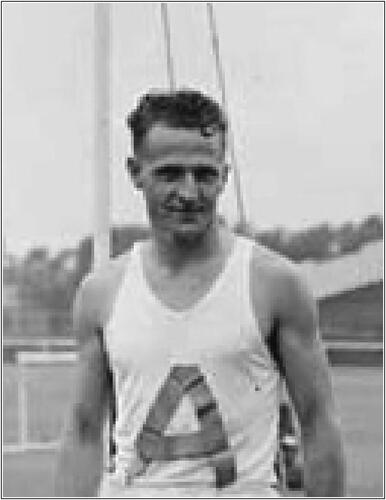
Bill Bowerman was an American track coach and a cofounder of Nike, Inc., with Phil Knight. Over his career, he trained 33 Olympic athletes, 51 All-Americans, 22 American record-holders, 22 NCAA champions, and 16 four-minute milers. Bowerman was coach for 24 years at the University of Oregon () and invented some of Nike’s top running shoes, including the Cortez and the Waffle.Citation2
Figure 2. University of Oregon track coach Bill Bowerman (left) and James M. Shea jogging at Hayward Field during the 1960s. Retrieved from https://oregondigital.org/concern/images/df669058q. Creative Commons License.
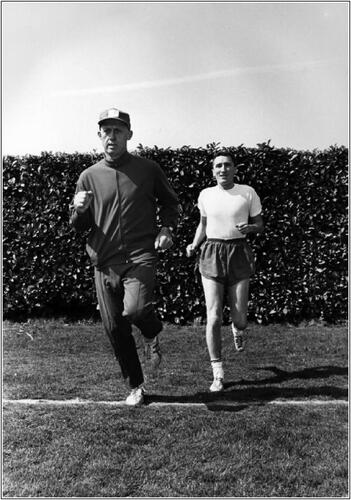
During a trip to New Zealand in 1962, Bowerman was introduced to the concept of running as a fitness routine, including for people of an advanced age, through a running club run by his friend and colleague, Arthur Lydiard. Bowerman brought these ideas to the United States. He began to write articles and books about running. In 1966, he and cardiologist W. E. Harris published a book titled Jogging, which sold over a million copies (). The difference between running and jogging is not standardized, but for most people running involves moving at about 6 miles per hour, or about a 10-minute mile; below that pace, one is likely jogging.
Figure 3. Bowerman’s book Jogging, “a medically approved physical fitness program for all ages.” The back cover highlights the benefits of jogging: “Jogging can be done by either sex at almost any level of physical fitness or age. It is free. It is easy. It is relaxing. It can be done alone or in groups. It is fun. It is good for the heart and lungs—the organs which may determine your life span.”
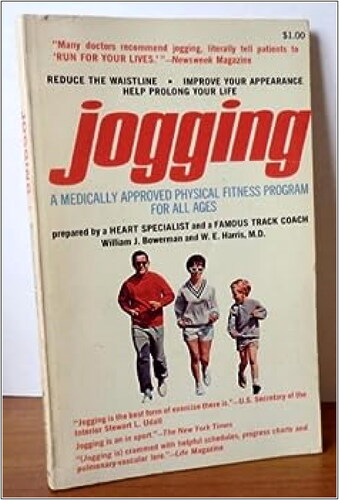
In 1966, John D. Cantwell, MD, an intern at the University of Florida Medical Center, published an article, “Joggers’ Club—A Means of Obtaining Cardiovascular Benefits from Daily Exercise.”Citation3 The discussion mentioned that Morris in 1953 had studied the incidence of coronary artery disease in relatively sedentary London bus drivers and more active conductors. He found that the former had twice the incidence of coronary disease. Dr. Cantwell then found that a joggers’ club had already been started by University of Florida track coach Jimmy Carnes and that the cardiac benefits of exercise might be found over time.
In 1968, Ken Cooper, MD, published his book Aerobics. It became a classic. During his Air Force career, he devised the simple Cooper test, which could establish fitness levels. Originally, the distance run in 12 minutes was correlated with the concept of VO2 max. Dr. Cooper assigned aerobic points for a variety of exercises and emphasized a point system for improving the cardiovascular system.
Cooper has published 19 books that have sold 30 million copies and have been translated into 41 languages. He became known as the “father of aerobics” (). His Cooper Clinic and Institute in Dallas, Texas, is a complex of 30 acres, with 24 full-time physicians, 6 PhDs, and a staff of 450. His research institute has published over 700 medical articles with over 50 years of data on 116,000 patients, 330,000 office visits, and 250,000 exercise stress tests. Dr. Cooper is still vitally active and energetic at age 92.Citation4 Ken’s son, Tyler Cooper, MD, is president and CEO of Cooper Aerobics and a preventive medicine physician at the Cooper Clinic.
In a 2014 issue of the Journal of the American College of Cardiology, Lee studied 55,137 adults from the Cooper Clinic in Dallas with a mean age of 44 years and compared the mortality risk between runners and nonrunners. Runners had a 45% lower risk of cardiovascular mortality and a 3-year increase in life expectancy over nonrunners during a 15-year follow-up.Citation5
The Peachtree Road Race I ran in 1975 had about 1000 runners then but is now the largest 10k race in the world, with over 60,000 runners. Galloway, an all-American runner for Wesleyan University and my mentor, was the first winner of the Peachtree Road Race in Atlanta in 1970, with only 110 finishers (which included Dr. John Cantwell). Galloway has always been a very good organizer of the Peachtree Road Race and has helped bring together world-class runners including Frank Shorter, Bill Rodgers, Don Kardong, and Lasse Viren.
Galloway graduated with a master’s degree from Florida State University and while at FSU became a member of the Florida Track Club based at the University of Florida in Gainesville coached by Jimmy Carnes and led by Jack Bacheler and Frank Shorter. Galloway, Bacheler, and Shorter made the 1972 US Olympic team; Shorter went on to win the gold medal in the marathon in the 1972 summer Olympics in Munich and the silver medal at the 1976 summer Olympics in Montreal (). In 1973, Galloway founded Phidippides, which developed into a nationwide franchise network of 35 running stores. Now he only owns two Phidippides stores in Atlanta. In 1974, Galloway began his run-walk-run method for beginning runners to help them enjoy the benefits of exercise.Citation6 For the past 48 years, he has been involved in fitness camps in California and Florida that have included many coaches and lecturers. He also conducts fitness seminars and marathon training groups all over the United States ().
Figure 6. Jeff Galloway meeting with runners in 2010. US Air 1Force photo by Josh Plueger (public domain).
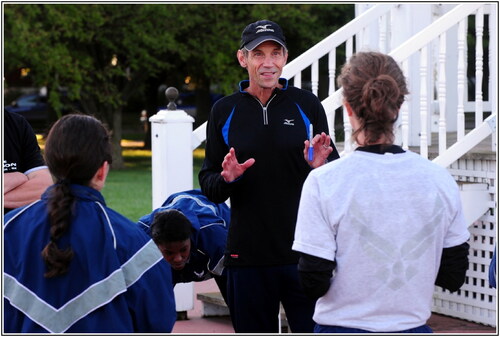
Over 2 years ago, Galloway was hospitalized after severe dizziness and had five coronary stents. He has recovered and at age 78 is able to walk and run with no symptoms. Before that, he was able to run a marathon once a month. He has trained an estimated half a million people and has published 32 books, working on number 33.
The running boom of the 1970s in the US was primarily a “jogging” movement, generally for recreation and fitness and later associated with a group of competitive road-running races during the decade. It has been estimated that 25 million Americans began some sort of running in the 1970s and 1980s, including President Jimmy Carter.
In summary, the modern jogging movement seemingly originated in New Zealand by coach Arthur Lydiard, spread to the United States by former Oregon track coach Bill Bowerman, and was amplified by Dr. Ken Cooper’s classic Aerobics and the 1972 Olympic marathon success of Frank Shorter. The additional accomplishment of other runners, such as Bill Rodgers and Jeff Galloway, fueled the momentum. Such activity has been shown to help reduce cardiovascular mortality in longitudinal studies at the Cooper Clinic.
Acknowledgments
The authors thank Jeff Galloway and John Cantwell for their help and support with this article.
Disclosure statement
The author reports no funding or conflicts of interest.
- Lydiard A, Gilmour R. Run to the Top. London: H. Jenkins; 1962.
- Moore K. Bowerman and the Men of Oregon. Emmaus, PA: Rodale; 2006.
- Cantwell JD. Joggers’ club. The New Physician, February 1966.
- Cantwell JD. Reflections on Kenneth H. Cooper, MD, MPH. Proc (Bayl Univ Med Cent). 2021;34(3):638–639.
- Lee DC, Pate RR, Lavie CJ, Sui X, Church TS, Blair SN. Leisure-time running reduces all-cause and cardiovascular mortality risk. J Am Coll Cardiol. 2014;64(5):472–481. doi:10.1016/j.jacc.2014.04.058.
- Galloway J. Galloway’s Book of Running. Bolinas, CA: Shelter Publications; 1984.


